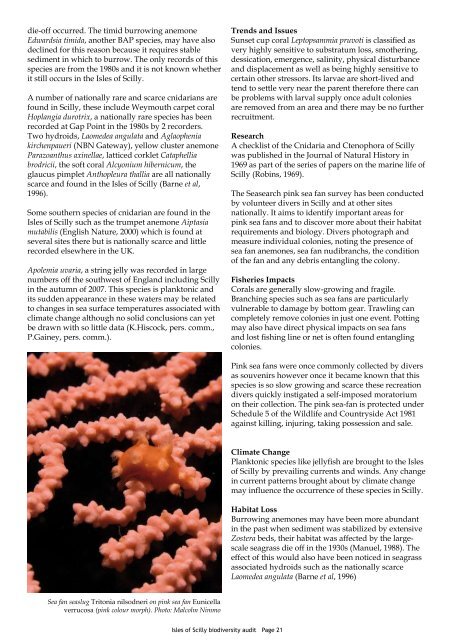The Isles of Scilly Biodiversity Audit 2008 - Cornwall Wildlife Trust
The Isles of Scilly Biodiversity Audit 2008 - Cornwall Wildlife Trust
The Isles of Scilly Biodiversity Audit 2008 - Cornwall Wildlife Trust
You also want an ePaper? Increase the reach of your titles
YUMPU automatically turns print PDFs into web optimized ePapers that Google loves.
die-<strong>of</strong>f occurred. <strong>The</strong> timid burrowing anemoneEdwardsia timida, another BAP species, may have alsodeclined for this reason because it requires stablesediment in which to burrow. <strong>The</strong> only records <strong>of</strong> thisspecies are from the 1980s and it is not known whetherit still occurs in the <strong>Isles</strong> <strong>of</strong> <strong>Scilly</strong>.A number <strong>of</strong> nationally rare and scarce cnidarians arefound in <strong>Scilly</strong>, these include Weymouth carpet coralHoplangia durotrix, a nationally rare species has beenrecorded at Gap Point in the 1980s by 2 recorders.Two hydroids, Laomedea angulata and Aglaopheniakirchenpaueri (NBN Gateway), yellow cluster anemoneParazoanthus axinellae, latticed corklet Cataphelliabrodricii, the s<strong>of</strong>t coral Alcyonium hibernicum, theglaucus pimplet Anthopleura thallia are all nationallyscarce and found in the <strong>Isles</strong> <strong>of</strong> <strong>Scilly</strong> (Barne et al,1996).Some southern species <strong>of</strong> cnidarian are found in the<strong>Isles</strong> <strong>of</strong> <strong>Scilly</strong> such as the trumpet anemone Aiptasiamutabilis (English Nature, 2000) which is found atseveral sites there but is nationally scarce and littlerecorded elsewhere in the UK.Apolemia uvaria, a string jelly was recorded in largenumbers <strong>of</strong>f the southwest <strong>of</strong> England including <strong>Scilly</strong>in the autumn <strong>of</strong> 2007. This species is planktonic andits sudden appearance in these waters may be relatedto changes in sea surface temperatures associated withclimate change although no solid conclusions can yetbe drawn with so little data (K.Hiscock, pers. comm.,P.Gainey, pers. comm.).Trends and IssuesSunset cup coral Leptopsammia pruvoti is classified asvery highly sensitive to substratum loss, smothering,dessication, emergence, salinity, physical disturbanceand displacement as well as being highly sensitive tocertain other stressors. Its larvae are short-lived andtend to settle very near the parent therefore there canbe problems with larval supply once adult coloniesare removed from an area and there may be no furtherrecruitment.ResearchA checklist <strong>of</strong> the Cnidaria and Ctenophora <strong>of</strong> <strong>Scilly</strong>was published in the Journal <strong>of</strong> Natural History in1969 as part <strong>of</strong> the series <strong>of</strong> papers on the marine life <strong>of</strong><strong>Scilly</strong> (Robins, 1969).<strong>The</strong> Seasearch pink sea fan survey has been conductedby volunteer divers in <strong>Scilly</strong> and at other sitesnationally. It aims to identify important areas forpink sea fans and to discover more about their habitatrequirements and biology. Divers photograph andmeasure individual colonies, noting the presence <strong>of</strong>sea fan anemones, sea fan nudibranchs, the condition<strong>of</strong> the fan and any debris entangling the colony.Fisheries ImpactsCorals are generally slow-growing and fragile.Branching species such as sea fans are particularlyvulnerable to damage by bottom gear. Trawling cancompletely remove colonies in just one event. Pottingmay also have direct physical impacts on sea fansand lost fishing line or net is <strong>of</strong>ten found entanglingcolonies.Pink sea fans were once commonly collected by diversas souvenirs however once it became known that thisspecies is so slow growing and scarce these recreationdivers quickly instigated a self-imposed moratoriumon their collection. <strong>The</strong> pink sea-fan is protected underSchedule 5 <strong>of</strong> the <strong>Wildlife</strong> and Countryside Act 1981against killing, injuring, taking possession and sale.Climate ChangePlanktonic species like jellyfish are brought to the <strong>Isles</strong><strong>of</strong> <strong>Scilly</strong> by prevailing currents and winds. Any changein current patterns brought about by climate changemay influence the occurrence <strong>of</strong> these species in <strong>Scilly</strong>.Habitat LossBurrowing anemones may have been more abundantin the past when sediment was stabilized by extensiveZostera beds, their habitat was affected by the largescaleseagrass die <strong>of</strong>f in the 1930s (Manuel, 1988). <strong>The</strong>effect <strong>of</strong> this would also have been noticed in seagrassassociated hydroids such as the nationally scarceLaomedea angulata (Barne et al, 1996)Sea fan seaslug Tritonia nilsodneri on pink sea fan Eunicellaverrucosa (pink colour morph). Photo: Malcolm Nimmo<strong>Isles</strong> <strong>of</strong> <strong>Scilly</strong> biodiversity audit Page 21
















